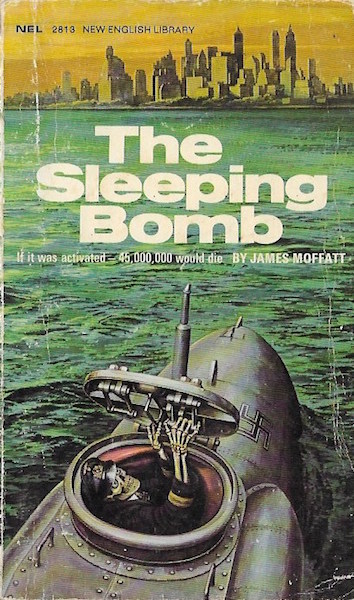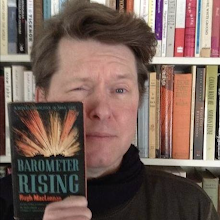As might be expected, most of the books added to the bookcase this strange year were bought online. You'll see I was particularly drawn to signed copies – something to do with the daily reminders of mortality, I suppose.
What follows are the nine other titles in this year's top ten.
Grant Allen
New York: Edward Arnold,
New York: Edward Arnold,
1897
The first American edition, this isn't the best of copies – I am not a wealthy man – but at US$27.00 it was a great find. Responding to my review of Allen's The Woman Who Did, a friend suggested that An African Millionaire is the author's better-known book. Perhaps, but is it as good?
Martin Brett [Douglas
Sanderson; trans Bruno
Martin]
Paris: Gallimard, 1955
The French translation of our greatest post-war noir novel. The story is abridged and Bruno Martin is clumsy, but that didn't stop me from also buying Estocade au Canada, his translation of Sanderson's A Dum-Dum for the President.
Pascal Berthiaume
Francis DesRoches
Pascal Berthiaume
Francis DesRoches
Quebec: Elite, 1932
A novel brought to my attention by Jean-Louis Lessard of Laurentiana. His review of this short novel of romance and small town politics intrigued. I was not disappointed!
Signed by the author.
Married, Yet No Wife;
A novel brought to my attention by Jean-Louis Lessard of Laurentiana. His review of this short novel of romance and small town politics intrigued. I was not disappointed!
Signed by the author.
Married, Yet No Wife;
Or, Told in the Twilight
Mary Agnes Fleming
Mary Agnes Fleming
New York: Street &
Smith, [c. 1916]
A fragile paperback published during the Wilson administration, it crumbles to the touch. The nineteenth-century Carleton editions hold up better, but I do like that cover. The title, which predates same-sex marriage in Canada by more than a century, intrigues.
PeeVee
Fred Jacob
Toronto: Macmillan, 1928
Bland boards, lacking dust jacket – please tell me one has survived – and still this ranks as one of my favourite finds. I've been meaning to read poor Fred Jacob for ages. The first sentence grabbed me: "In the Hortop family, innovation was looked upon as something to be combated."
Fred Jacob
Toronto: Macmillan, 1928
Bland boards, lacking dust jacket – please tell me one has survived – and still this ranks as one of my favourite finds. I've been meaning to read poor Fred Jacob for ages. The first sentence grabbed me: "In the Hortop family, innovation was looked upon as something to be combated."
Toronto: McClelland &
Stewart, 1922
An early Canadian mystery, this is Lauriston's only novel. Amongst his other books are A Century of Milling, 1848-1948: the story of the T.H. Taylor Company Limited, Chatham, Ontario and Blue Flame of Service: A History of Union Gas Company and the Natural Gas Industry in Southwestern Ontario. Inscribed by the author.
An early Canadian mystery, this is Lauriston's only novel. Amongst his other books are A Century of Milling, 1848-1948: the story of the T.H. Taylor Company Limited, Chatham, Ontario and Blue Flame of Service: A History of Union Gas Company and the Natural Gas Industry in Southwestern Ontario. Inscribed by the author.
Mine Inheritance
Frederick Niven
Toronto: Dent, 1945
Niven never had much of a profile, so how is it that Mine Inheritance, of which I'd never heard, was once abridged and edited as a school text? This copy, found in an Ottawa bookstore, came from the library of Henry C. Miller, founder of the legendary Graphic Publishers.
Frederick Niven
Toronto: Dent, 1945
Niven never had much of a profile, so how is it that Mine Inheritance, of which I'd never heard, was once abridged and edited as a school text? This copy, found in an Ottawa bookstore, came from the library of Henry C. Miller, founder of the legendary Graphic Publishers.
Indianapolis: Bobbs-
Merrill, 1944
The last of Stringer's forty-four novels, I purchased this on a whim, sight unseen, from an online bookseller located in author's birthplace (Chatham, Ontario). Hollywood figures, as it did in the life of the author. Will you look at that cover! Signed by Stringer!
The last of Stringer's forty-four novels, I purchased this on a whim, sight unseen, from an online bookseller located in author's birthplace (Chatham, Ontario). Hollywood figures, as it did in the life of the author. Will you look at that cover! Signed by Stringer!
Toronto: Longmans, 1959
The first edition of the author's first novel – signed by the author, with a gift inscription from her mother – how this ended up in a Wallingford, Oxfordshire bookshop is anyone's guess. It has now been repatriated. I made the purchase while working on the Ricochet reissue of The Ravine, Phyllis Brett Young's only thriller.
Three generous souls sent books which, had they not been gifts, would have been considered amongst the year's best buys:
Atomic Plot
Joe Holliday
Joe Holliday
Toronto: Allen,
[1959]
Of the fourteen Dale of the Mounted books, this is the one I'd most wanted to read. I mentioned as much when reviewing Dale of the Mounted: Atlantic Assignment. Chris Otto of Papergreat heard my wish.
CAW-CAW Ballads
Wilson MacDonald
Toronto: The Author, 1930
Number 449 in this "AUTHOR'S EDITION, WHICH IS LIMITED, NUMBERED AND AUTOGRAPHED." The poet inscribed this copy to Healey Willan. A gift from Fiona Smith, does this go in my MacDonald collection or my Willan collection? I can't decide!
Wilson MacDonald
Toronto: The Author, 1930
Number 449 in this "AUTHOR'S EDITION, WHICH IS LIMITED, NUMBERED AND AUTOGRAPHED." The poet inscribed this copy to Healey Willan. A gift from Fiona Smith, does this go in my MacDonald collection or my Willan collection? I can't decide!
Jacket Coates
Herbert Fairly Wood
Toronto: Longmans,
Herbert Fairly Wood
Toronto: Longmans,
1966
A gift from old pal James Calhoun, who worked with me in returning Peregrine Acland's All Else is Folly to print. The Private War of Jacket Coates is Canada's only novel of the Korean War. How is it that there was only one? And why is he title so bad? I aim to find out.
There's more to my purchase of Arthur Beverley Baxter's The Blower of Bubbles. On that day I was in Perth for the celebration of the 101st birthday of André Hissink, my grandfather.
A man born in 1919, in the midst of the Spanish Flu pandemic, two months after his 101st birthday he came down with COVID-19... and he beat it.
Here's hoping I share those genes.
Here's hoping you all are safe and well.
Related posts:

























